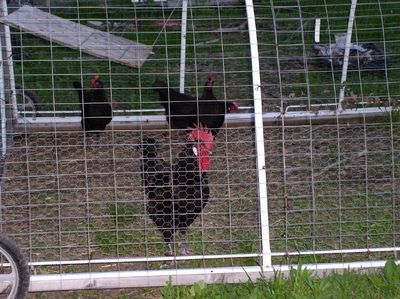Hi Chickencanoe, I hope you get through the legal issues. We exchanged pms some time ago and I have always planned on obtaining eggs from you,however health problems have kept me from doing much breeding, that said I managed to hatch about 20 black Penes this spring from 2 hens that came from Sandhill. I have a third hen that I have yet to breed. Just letting those who wish to know my experiences with my Sandhill Penes
I think that if one plans to breed any rare breed you should expect lots of faults and Penedesencas are no exception. My Penes are not friendly to put mildly. This type of personality is not going to make them popular with most back yard chicken keepers who like a " quiet easy going pet ". They do however lay lots and lots of large and extra large eggs.All three of my hens lay a very dark, darker than a RIR or Plymouth Rock, but not as dark as the darkest you see in pics. Earlobe color is not consistant but if you look a some pics from Spain,many birds have red ear lobes. There are also some color on the hackles wings and saddles on some of the males. Understand that this is from a very small number of birds and may not be representative of Mr Drowns Penes. They are better than I expected. Hope this helps somebody. Bill
I
Oldhound, I couldn't agree with you more. When I brag about their qualities the people in my classes want them and I warn against. Primarily because they will never make a lap chicken. The standards I've translated into English specify that they be rustic. I construed that to mean hardy/sturdy/strong.
muy rústica y de temperamento inquieto which in Catalonian means very rustic and of a restless temperament.
But when I looked for other possible translations, it turns out that rústica also means wild. So following the European standards - they should be wild.
Give them a coop, lock them in at night and during the day they fend for themselves.
Eggs are supposed to be 60 grams minimum. Mine range from 60-80 meaning most are extra large to jumbo.
There are faults. I started with 10 roosters and only 2 were pure black. Those were the only ones I bred to my hens.
The eggs were not as dark as I expected but many are very dark, darker than some of my friends Marans eggs.
Other faults, I have some cockerels with a copper/red feather or two in the hackle or back. Some of my hens, though pure black to begin with showed some mottling (white tips) after the first molt. For the time being, this is all I have to work with. They have the shape of the Spanish birds and I think I can correct these issues. (if I can still keep chickens) I want a hardy bird with the right shape, dark eggs, nice white lobes, proper carnation comb, good size for meat and pure black plumage.
Last edited:







